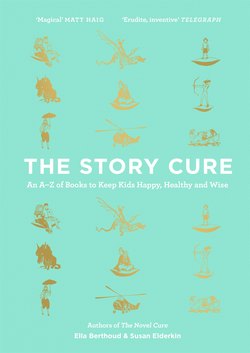Читать книгу The Story Cure - Ella Berthoud - Страница 7
ОглавлениеINTRODUCTION
Between ‘Once upon a time’ and ‘happily ever after’ is a land we’ve all been to. Strange and marvellous things happen there.
Sometimes they’re things we don’t normally get to do – like riding on the back of a dragon, or finding the golden ticket to the chocolate factory. Often they’re things we want to do but are too scared or sensible – like running away from home. And sometimes they’re things we wouldn’t want to happen to us at all, but we’re very curious to know what it’d be like if they did – like being orphaned, or stranded on a desert island, or raised by a badger, or tragically turned into a rock. By the time we come back, brushing the dust off our hats, a new, worldly look in our eye, we alone know what we’ve seen, experienced, endured. And we’ve discovered something else, too: that whatever is going on in our actual lives, and whatever we’re feeling about it, someone else has felt that way too. We’re not alone, after all.
When we suggested, with our first book The Novel Cure, that reading the right novel at the right time in your life can help you see things differently – and even be therapeutic – the idea was surprising and new. That children’s books can do the same for children won’t surprise anyone at all. Parents, godparents, grandparents and kindly uncles – not to mention librarians, English teachers and booksellers (who are, of course, bibliotherapists in disguise) – have long been aware that the best way to help a child through a challenging moment is to give them a story about it, whether they’re being bullied at school, have fallen in love for the first time, or the tooth-fairy failed to show up. The best children’s books have a way of confronting big issues and big emotions with fearless delight, their instinct to thrill but also, ultimately, to reassure.1 No rampaging toddler ever feels quite so out of his depth after Where the Wild Things Are. No pre-teen girl so alone with her questions after Are You There, God? It’s Me, Margaret.
In this book, you’ll find the very best children’s books to give to (or read with) the kids in your life – whether they’re three or thirteen, love books or avoid them, can’t sit still, want more toys, have nits or nightmares, or are desperate for more independence. For many of us, a favourite book from childhood is among our most treasured possessions – not just any copy, but the actual copy we owned, defaced with wax-crayon scribbles and with the pop-up bits torn off. For Susan, it’s a copy of Go, Dog. Go! by PD Eastman, with its endless litany of dogs, big and little, spotted and plain, driving in open-topped cars, or sleeping in the biggest bed you ever saw, then leaping out in a blaze of colour and light when it’s time to wake up. Each time it was read – or, rather, pored over, because this book is all about the detail in the pictures – there was the chance of sharing a new, hidden joke with the author: the one dog that has his eyes open in the middle of the night, or is still snoozing at daybreak. For Ella it’s her copy of Tarzan of the Apes by Edgar Rice Burroughs – the first in a series of twenty-four Tarzan adventures which she gulped down, one after the other, their yellowed pages teeming with the screeches and calls of the jungle. And, in the margins – sometimes running over onto the text – her own colourful attempts at sinuous snakes and bright-winged parrots and leaping monkeys. Potent time capsules, they seem to contain not just who we were, but who we dreamed we would one day be.
Which books our own children hang on to from their childhoods is anyone’s guess – but they’ll surely be of the physical, tangible kind. Tablets are brilliant for beaming up a book in an instant; but engaging the senses of touch and smell, as well as sight, makes it so much easier to get lost in a book.
That’s when we get transported. That’s when we go to the land.
So, if you’re sitting comfortably, let’s begin.
1 There are notable exceptions, of course: fairytales in their darkest forms, Hilaire Belloc’s Cautionary Tales for Children and Heinrich Hoffmann’s Struwwelpeter . . . all of which help to keep psychiatrists in business.
